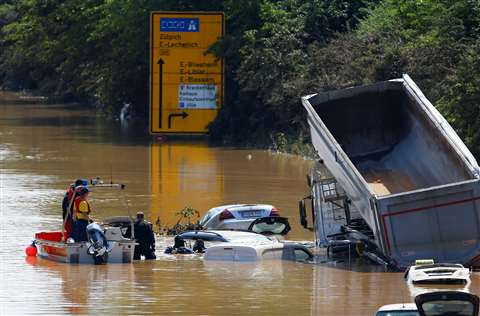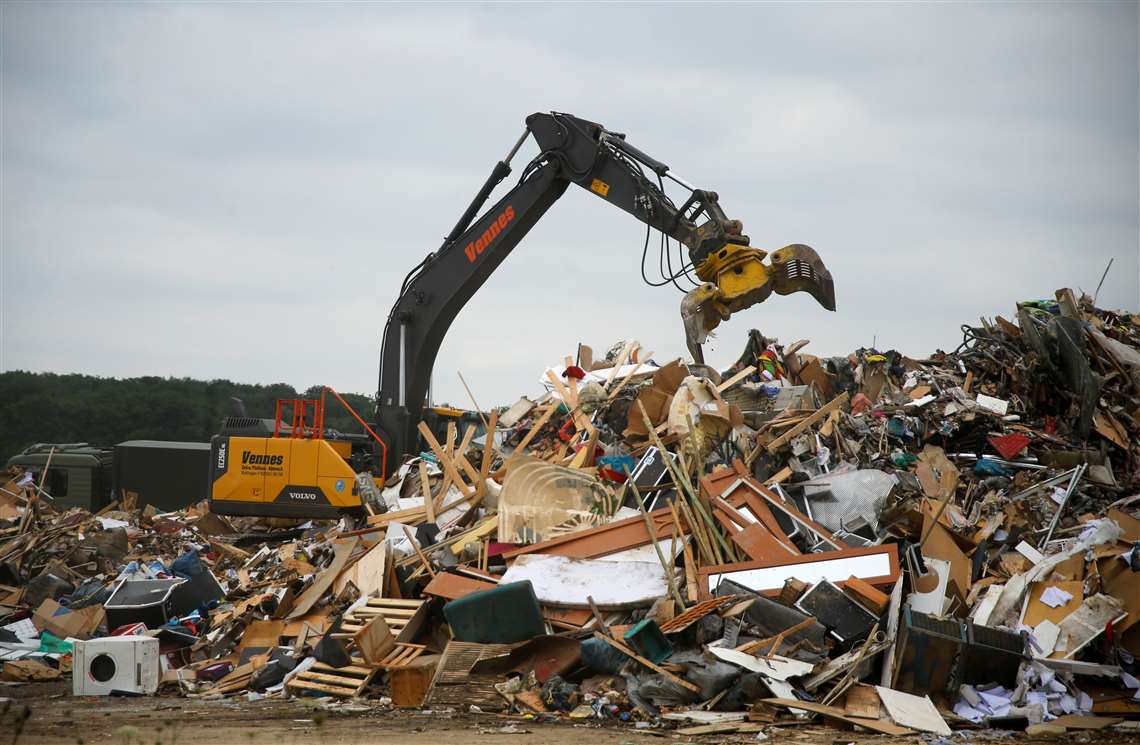21 July 2021
Local contractors and other construction industry specialists have been among those first to respond in the wake of disastrous floods sweeping much of central Europe last week.
 Divers search stranded vehicles on a flooded road in Erfstadt, Germany (Photo: Reuters.)
Divers search stranded vehicles on a flooded road in Erfstadt, Germany (Photo: Reuters.)
Volunteers from the construction industry are among those who went out in force last week helping with rescue and cleanup efforts in the wake of catastrophic flash floods in Western Europe.
Heinz-Gert Kessel, the head of the Franz Bracht Group mobile crane planning and consulting department in Germany and KHL special correspondent, has been busy for the past couple of days with his shovel helping to dig neighbours out of their collapsed houses.
“It is like after a war,” says Kessel,” who lives just 2 km from the evacuation zone around one of the worst affected areas. “We moved all of our things to the second floor, including all of the things in my office. Most of the houses in the area have water in the cellar.”
Kessel’s home town of Erftstadt, a commuter-belt town 20 km south of Cologne, is one of the worst affected areas in floods across Western Europe which left nearly 200 people dead and many more missing.
“It is like after a war”
The floods, which came as a surprise to many, left residents trapped in rising flood waters, swept away homes, cars and infrastructure and caused billions of euros worth of damage across Germany, Belgium and the Netherlands.
In Kessel’s home state of North Rhine-Westphalia alone at least 47 people died. At the time of writing the town was without gas connections and some areas were without electricity. Parts of the town’s A1 motorway have crumbled and collapsed into the River Erft cutting the town off from fast road connections to the north.
“This is the sort of thing that you might expect to happen perhaps only once in about a hundred years,” says Kessel in disbelief. “We did not even think at all to be in danger. When it comes to heavy rain it all happens very fast. There is no time at all.”
And, with communications down and essential infrastructure crippled, Kessel says, for the first few days after the floods, German contractors have often been at the forefront of rescue and clean-up efforts.
“So much has to be done,” he says. “Contractors have been using loaders, excavators, dumpers and heavy transport to deliver things like sand for the sandbags. It was hard in the first two days to come through by road and to be everywhere where help is needed for uncommonly this flood covers a large part of Germany.”
Rental company BBL Baumaschinen, was also amongst those in the construction industry rushing to help.
As soon as the floods hit, a team of three loaded a Caterpillar D6 20 tonne tracked bulldozer, three CAT excavators (320, 329 and 336) and a Volvo wheeled loader onto a low-loader truck and headed straight to the disaster-stricken town of Bad Neuenahr Arhweiler.
“On Thursday we heard about the terrible events in the affected areas. We made a lot of phone calls but, despite this, we couldn’t reach anyone co-ordinating the rescue and clean-up efforts,” says BBL marketing manager Anna Britz. “So, on Friday morning we drove off on our own initiative with the equipment.”
“Whole houses were washed away”
When they got to the normally scenic spa town in Rhineland-Palatinate, the BBL team were shocked by what they saw.
“The banks along the Ahr had been completely destroyed,” says Britz. “Whole houses were washed away. All the bridges were destroyed and there was rubble everywhere.”
With few local authorities contactable to give direction, the BBL team initially joined a mishmash of heavy equipment owners, working together to clear the roads to make them passable. “With us there were mainly farmers with their tractors and a few other builders and contractors,” Britz says.
Eventually a local politician started organising work on the ground and, together with partner company Markus Zintel, the BBL machines were put to work making temporary repairs to a 100 metre stretch of the main 267 highway, which had been washed away at the point where it crossed the river. Trucks from German power company RWE were soon part of the operations, supplying diesel for the machinery and 1,000 tonnes of gravel.
Isolated for four days
“From Friday to Sunday our team worked almost continuously, dredging ballast from the river and rebuilding the road,” Britz says. “On Sunday, by 3pm, you could finally walk across the river. The first house we got to had been completely cut off for four full days. Inside we found a family and an elderly woman in need of care who had been isolated for four days without electricity, drinking water or a working toilet.”
And the efforts of Kessel and the BBL team are far from unique. As the flood waters begin to recede, more and more stories are surfacing of construction professionals using their equipment and expertise to help during the crisis.
The German construction industry association Hauptverband der Deutschen Bauindustrie (HDB) says that its regional associations have been inundated with offers of help from its members which it has passed on to the respective municipalities.
“The construction industry is using all means possible to help the people in the disaster areas. Quick help is now the top priority and has to get to the affected areas quickly,“ says Inga Stein-Barthelmes, head of politics and communication at HDB. “Regardless of whether it is cleaning up, securing roads, slopes, residential areas, or bridge commissions. We help where we can.“
“We help where we can”
But when asked whether the German authorities have responded quickly enough to state weather warnings and whether they had been able to coordinate rescue and clean-up efforts quickly and effectively enough to deploy construction volunteers efficiently, Stein-Barthelmes remains circumspect.
Under Germany’s decentralised system, disaster warning and recovery functions are passed down to city and county councils in the country’s 16 federal states. Each municipality is then responsible for co-ordinating its own clean-up.
“One should not make association politics with this topic,“ she says. “It would be important, however, if the public sector could say in concrete terms what, when and where is needed. Then our companies can reallocate, reschedule or increase their capacities.“
In neighbouring Belgium, where another 31 people were killed by the floods and whole neighbourhoods wrecked by the waters, contractors again have been quick to support clean-up efforts.
The country’s construction industry body, Confederatie Bouw has even published a list of firms offering help following the floods.
The construction industry in Belgium is trying to help as much as it can
“The construction industry in Belgium is trying to help as much as it can,” says Sven Nouten, press relations manager. “Our organisation has created a list on which companies willing to help can subscribe. People can see on this list where to find contractors able to help. The companies can help repairing houses and infrastructure or they can stabilize them.”
However, Nouten points out that Belgium’s initial clean-up efforts have been hampered by the fact that the floods have occurred during the country’s national holiday season.
“The problem is that most construction companies are closed at the moment due to the holidays,” Nouten adds. “In Belgium there is some kind of agreement between construction companies to go on holiday during the three last weeks of July. However, that’s not an obligation, so there are contractors at work at this moment and able to help in the flooded areas.”
In the Netherlands too, where water levels rose to record levels damaging homes and properties in the south of the country, Dutch construction association, Bouwend Nederland, says that its members have also been pitching in with efforts such as delivering extra sand supplies to reinforce dykes.
And, the organisation says that contractors also have a role to play in preventing the effects of flooding in the first place with better water management.
In the Netherlands, where almost a third of the country lies below sea level and the country relies on a series of dykes to protect it from flooding, diverting flood water away from populated areas and creating a series of lakes and parks designed to flood if necessary, has become public policy.
Climate adaptive construction
“We have been emphasising to our clients for several years now the importance of climate adaptive construction,” says Niels Winsing, BN communications manager. “This can vary from creating more space for water absorption by means of widening riverbeds and lots of other measures to making adaptations to the infrastructure and the construction itself.”
Back in stricken Erfstadt where rescue services are still working to clear wrecked cars and trucks from brown flood water, the catastrophic floods are bringing the climate change debate to the top of the political agenda. In the wake of the floods, politicians on all sides have been quick to link the deluge to global warming.
Kessel is adamant that more must be done to prevent the same thing happening again. “There is just not enough being done to mitigate the effects of global warming,“ he says. “In Germany and many other countries. There is much talking but no real concept.“
STAY CONNECTED



Receive the information you need when you need it through our world-leading magazines, newsletters and daily briefings.
CONNECT WITH THE TEAM










